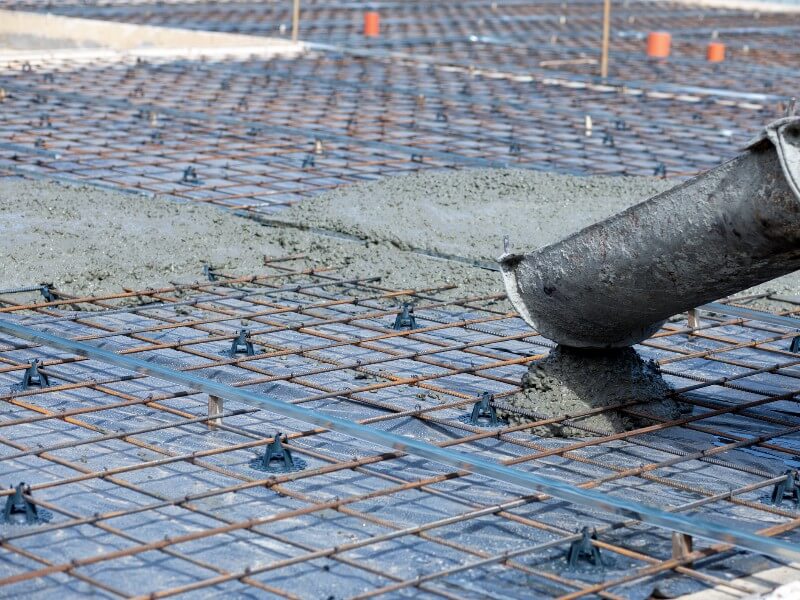
There are several components involved in building a property, even the simplest ones. In the case of a structure with more than one story, a slab is necessary to distribute the weight among the beams and ensure their support. However, there are different types of slabs, each with their own advantages and disadvantages.
For those working in construction, understanding the various structures, parts, and materials available is crucial. This is both to optimize budgets and ensure safety.
To help you choose the best material, we'll discuss the main types of slabs, their characteristics, and what to consider when making your decision. Stay tuned.
For a layperson, it can be difficult to understand all the details and different parts that make up a house or building. The construction of the foundation, the pillars, and the use of different... metals in civil construction are elements that go unnoticed by most people.
However, for professionals in the field, each of these elements plays a fundamental role in the composition of the structure as a whole, especially the slab. Understanding the differences between these types is important both for achieving the best results and for facilitating project planning and management.
There are a wide variety of slabs in civil construction, each with its own pros and cons. Understanding the main differences between these materials and the types of slab coverings is essential to choosing the best one for your construction.
Check out the main ones and when they are recommended here.
Also called a simple slab, this is one of the most common types. As the name suggests, this slab is constructed using a very basic process. First, a wooden mold is made, which receives a steel reinforcement, which contributes to its support. Concrete is poured into this mold, forming the slab over the structure.
It's most commonly used in smaller-scale projects, such as small residential or commercial properties. Due to the high volume of concrete, this slab is often quite heavy, placing greater demands on the building's support columns, in addition to the higher cost of raw materials.
This type of slab gets its name from the shape of the concrete used in the structure. It's a set of T-shaped beams, making the slab much thicker than normal. At the same time, the amount of concrete used in the filling is much smaller.
On the other hand, this structure also significantly improves weight distribution, allowing it to be built over large areas with far fewer columns. Ideal for creating large open spaces that are still covered.
It's very similar to a solid slab, but with one important difference: the weight is distributed across several beams, each with a reinforced surface on top. This creates the mushroom-like appearance, hence the name.
The slab's thickness also increases, resulting in higher concrete and steel costs. However, it's easy to install, which reduces labor costs and the risk of accidents during construction.
THE steel truss It's a very common product in various constructions. This structure has a triangular pattern, which optimizes weight distribution. As a result, you have a much stronger piece, but one that uses less steel in its composition.
Based on this principle, the lattice slabThese structures are among the precast slab types and receive concrete addition, forming a simple and efficient slab. The overall strength of the structure may not be as high as other formats, but it costs less and performs well in small spans.
As the name suggests, this is a type of slab that comes in pre-assembled sections, which are then fitted into the rest of the structure. In many cases, the gaps are filled with polystyrene, but the concrete and steel components arrive at the construction site already completed.
The fitting and finishing process tends to be more expensive, but assembly is usually quick and easy. This is especially important if you have a tight deadline to complete the project.
Now that you know the different types of slabs, all that's left is to decide which one is best for your project. Here are some tips to help you make the right decision.
First, you need a good supplier to ensure the best possible slab integrity, whether prefabricated or built on-site. This means choosing a company that uses products of quality, with a good reputation within the construction sector.
Another important factor is the budget of the project. Since resources are always limited, it's necessary to consider options that meet your needs without exceeding your material spending limit, as planned. And, as you can see, some slabs have a lower construction cost.
Along with cost, you need to consider time. Some more elaborate structures may require less material and be durable, but this increases the completion time. If the project is on a tight schedule, you can choose a slab type that allows for quick construction.
There is considerable variation in the materials used in different types of slabs. Concrete itself already undergoes considerable variation depending on its formula, as does steel resistance. Check which materials will be used in the construction and whether they meet the structure's needs.
Knowing how to choose between different slab types will significantly improve the efficiency of your projects. Not only from a budget perspective, but also with a better end result that closely matches your project planning.
Want to keep receiving information to improve your builds? Then read other blog content and learn more about Ceará Steel Group on our website!